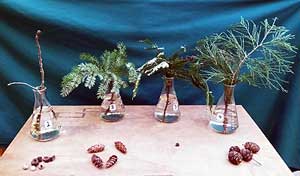February Color Appears at the Washington Park Arboretum

Donald Culross Peattie in the Washington Park Arboretum
Staff horticulturist, Ryan Garrison recently listened to an audio version of Donald Culross Peattie’s book, “A Natural History of North American Trees.” He very much enjoyed its mix of science and literary art, and would like to share a few gems about trees in the collection with you.
1) Carya ovata – Shellbark or Scalybark Hickory
“To everyone with a feeling for things American, and for American history, the Shagbark seems like a symbol of the pioneer age, with its hard sinewy limbs and rude, shaggy coat, like the pioneer himself in fringed deerskin hunting shirt. And the roaring heat of its fires, the tang of its nuts – that wild manna that every autumn it once cast lavishly before the feet – stand for the days of forest abundance.” 1
2) Pseudotsuga menziesii – Douglastree; Douglas, yellow, or Red Spruce; Oregon Pine
“In the literature of forestry it has wavered between Douglas Fir and Douglas Spruce, though it is no Spruce and no true Fir, as botanist see matters. Some years ago the Forest Service officially settled on “Douglas Fir” and if this impaction seems to you to clear up matters, you may use it with the blessings of the Government Printing Office. The least misleading of proposed names is Douglastree, since it leans on no analogies and still does honor to that noble pioneer among explorer-botanists of the Northwest, David Douglas.” 1
3) Sequoia sempervirens – California Redwood, Coastal Sequoia, Sempervirens, Palo Colorado
“Your footfalls make no sound on the needles and moss that have lain there for centuries. Your body casts no shadow in that green, lake like diffused light. The goose honking of a car, the calling of a child, fade into the immensity of silence. Time, the common tick-tock of it, ceases here, and you become aware of time in another measure – out of an awesome past. For this forest has stood here since the Ice Age, and here, together with this transfixed past, is the future too, for these immense lives will outlast yours by a thousand years or so.” 1
4) Sequoiadendron giganteum – California Bigtree; Sierra Redwood; Mammoth-tree
“The summers are exceedingly dry; if rain does fall it is apt to come with violent thunderstorms and lightning bolts that have been seen to rive a gigantic Sequoia from the crown to its roots. Those who know the species best maintain that it never dies of disease or senility. If it survives the predators of its infancy and the hazard of fire in youth, then only a bolt from heaven can end its centuries of life. Perhaps, if this majestic tree had a will, it would prefer to go this way, by an act of God.” 1
1 Peattie, Donald Culross, and Paul Landacre. A Natural History of North American Trees. Boston: Houghton Mifflin, 2007. Print.